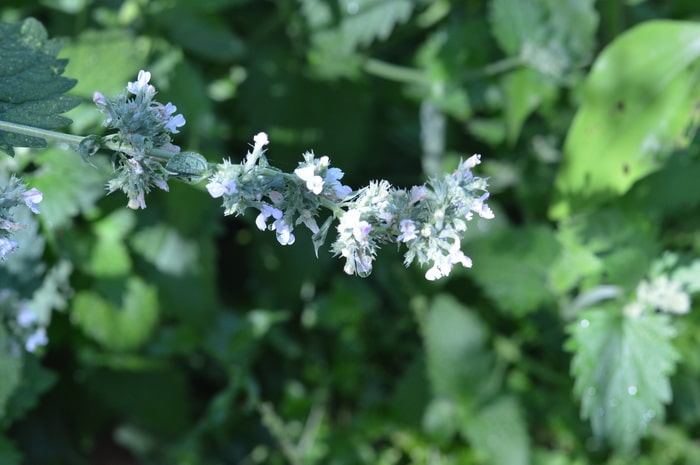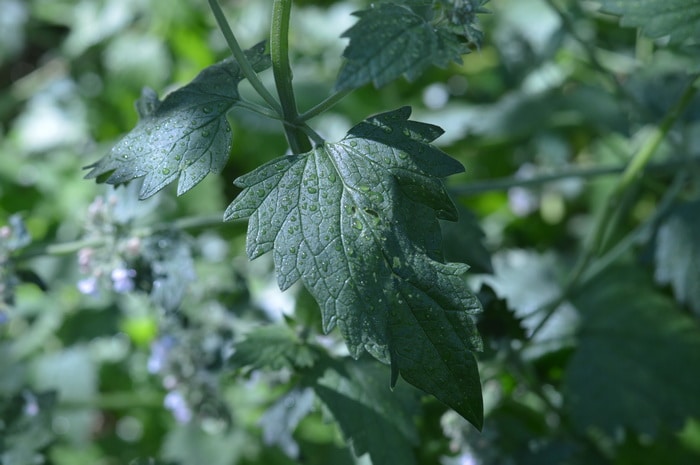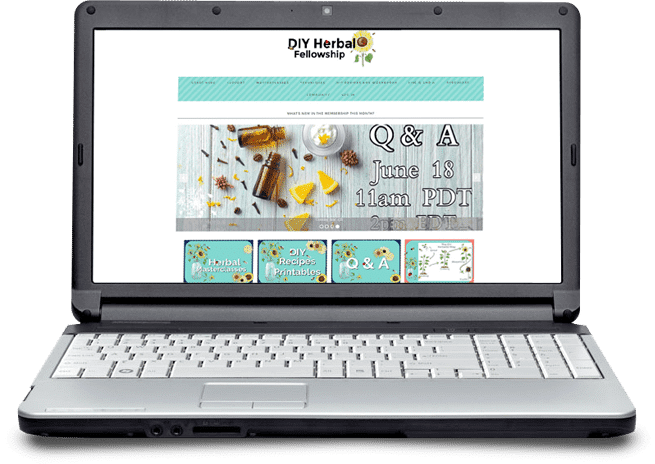Learning how to grow catnip, a mint family plant, is easy and straightforward. This barely scented, white flowered perennial attracts bees, butterflies, cats, and children to your garden. It is also a calming home remedy that is safe for children, the elderly, and pregnant mothers.
Catnip (Nepeta cataria) is a mild mannered member of the mint family. Although mints are known as a highly invasive, due to their aggressive spread, catnip does not self propagate from root runners as much as other mints. It prefers to grow in clumps, and will self-seed. This less invasive member of the mint family, compared to English mint, or chocolate mint, is safe to companion plant in regular garden beds, as long as flower spikes are trimmed back before seeds drop. If you place flowering stalks in your compost and it doesn’t get hot enough, you could spread catnip by seed to the entire garden.

Now, if there are a lot of cats around, containers may be advisable, or cat defenses may be needed to protect the crown of the plant, or seedlings. Cats are the number one pest of catnip.
Catnip is a beautiful plant with heavily toothed edges, white spikes of flowers, and is considered a delicacy by bees. It likes moisture, but can tolerate drier soils, and is relatively drought hardy. It is winter hardy in zones 3 to 9. In general, it is a hardy perennial herb and has abundant gray-green foliage, making it very attractive in borders and garden design.
Last year our honey bees and native pollinators coved the catnip and ignored most other plants. We had white, floral honey as a result! Butterflies also frequent catnip, and it can help attract other beneficial insects as well. Lacewings are attracted to catnip, and lacewings are a main predator of aphids and garden mites.
There is a lemon scented catnip, that is attractive to bees. The leaves can be used as a mosquito repellent in the garden.

How to Grow Catnip:
All varieties of catnip can be grown from seeds, or from rooted cuttings. If you have a friend with a plant, get cuttings in the spring or early summer, Richter’s Herbs carries the seeds for both regular catnip and lemon catnip in Canada.
Start catnip seeds indoors, about 8 weeks before the last frost date for your area. I like starting all my herbs at the same time. The eight week margin gives plenty of time for the seedlings to grow, and helps give a longer harvest season too.
Catnip thrives in full sun, but can tolerate partial shade in the heat of summer. It will grow to 18 inches to 24 inches in a single season, so give it room to sprawl on the edge of you garden.
To start growing catnip from seed, indoors, prepare small seedling pots with fresh potting soil or seed starting mix.
Wet down the soil, so that it is wet but not soaked, and sow seeds on the soil surface at a rate of 2-3 per seedling pot. Lightly cover with potting mix. Keep evenly moist and the catnip seeds should germinate in 7-14 days.

When plants are 2-3 inches tall, pot up, or harden off and plant into the garden. When planting catnip into the garden, make sure to protect the plants from marauding cats. An upturned and pegged down laundry basket or metal basket works well. Once the plants are well rooted cats wouldn’t endanger it.
Catnip may also be grown in containers. Use fast draining potting soils, since catnip doesn’t like wet feet. Place the pot in full sun.
Catnip seeds can also be direct sown in the garden, up to two weeks before the expected last frost date. Catnip plants are frost hardy, and don’t mind a touch of frost. Make sure the planting area is protected from cats, or you may loose the seedlings upon germination. To avoid loosing tender sprouts, cover the area before the seeds sprout.
Catnip from Cuttings:
Trim the stems of a mature, or nursery purchased, catnip plant. Trim off the leaves up to two inches up the stem.
Place in a glass of water. Change the water daily, and monitor for root formation. Keep warm. The cuttings should root within a few days to a week.
Alternatively, use rooting hormone and stick the cut stems in a pot of damp potting soil, then cover with a humidity dome until the cutting sends out new growth.

Catnip or Catmint?
Many people confuse catnip and catmint. Even old herbals will refer to Nepeta cataria as catmint. In fact in UK catnip is called “catmint”. While these two plants are in the same family, the nepeta sub-family, of the mint family, they are different phenotypes. Catnip, the wild cousin, has white flowers, while the tamer catmint has showier purple blossoms. Catnip (Nepeta cataria) is the nepetolactone chemotype, with strong insecticidal properties, along with other benefits. This is the catnip used in traditional herbal medicine. While catmint (Nepeta faassenii) is the 1,8-cineole and/or linalool chemotype. (Source) Both have antioxidant, antimicrobial, nervine properties though, but only catnip has that opiate effect on cats. Catnip is hardy to zone 3, catmint likes zones four and above. Finally, catmint has more of a minty flavor, from the linalool and 1,8 cineole terpenes. Should you pour a cup of tea from catmint? Sure, both catnip and catmint can be used in tea, though the flavor will be different. They are mint family plants and are nontoxic. (If you are pregnant though, don’t use medicinal amounts. Catnip has uterine effects).
Caring for Mature Catnip:
Mature catnip plants can be up to three feet tall. When they bloom, the area will buzz with bees, and other friendly pollinating insects. Trim back flowers as they begin to fade to encourage further blossoming, and to prevent self-seeding. A well manage catnip planting will provide nectar and pollen to pollinators well into the fall, until your area gets a hard frost.
Prune the edges of your catnip clump to keep it tight, and cut off any runners that try to invade other areas of the garden. For propagating catnip super easily, simply dig up those runners and place them in pot for next year’s garden.
Troubleshooting Catnip:
When considering how to grow catnip successfully, there are a few pests that can affect it. In general, it’s sweet scent, and the lacewings it attracts, actually help keep insect pests at bay. However, it’s large leaves are attractive to some pests, even then. Plants that are stressed are more likely to experience insect damage, so if you notice any of these problems, assess the stress levels of your plants. Is it especially hot? Did you mulch their root zone to inhibit evaporation? Are they over crowded? Do you need to thin out the planting or trim the growing stalks to provide additional airflow? Are the leaves yellowing? Do they need additional fertilizer?
Whiteflies can affect catnip either during the seedling stage, if growing indoors, or outdoors if there’s an outbreak. Indoors, whiteflies can be vacuumed up, carefully, from around seedlings and other indoor plants. A few days vacuuming usually takes care of them. There are also a few natural solutions to explore, if the infestation is outdoors.
Spider mites usually seem to strike indoors, I’ve rarely seen them outdoors, but their distinctive webbing and the desiccation of plant leaves are a dead give-way. Indoors, wipe the plant off with soapy water, or a spray bottle of lightly soapy solution. Wipe down plants twice to three times a day, and remove affected leaves to also remove eggs. It can take a week or two to completely defeat the infestation indoors, outdoors you have insect allies that help a ton. If you experience spider mites outdoors, spray them off the plant with a strong spray of water, clean up any fallen leaves. Mulch the ground to reduce heat stress. Your outdoor plants will outgrow the infestation when they are receiving adequate water and plant food.
Flea beetles are unimpressed with catnip, and basil too, and planting it near plants that flea beetles love can help protect those crops. Even catnip seedlings can help repel these bugs from crops like eggplant, that flea beetles love to decimate. Catnip is a companion to carrots, parsnip, beets, and roses, where flea beetles are a problem.
Fresh catnip leaves can act as a mosquito repellent, and lemon balm, lemon verbena, and bee balm also have a similar affect. They are great choices for anti-mosquito deck planters, or doorway planters.

Catnip and Cats:
About 50% of cats are affected by cat nip. Younger cats are more likely to respond to it, than older cats. Even large cats, like cougars and tigers are attracted to it. But too much catnip stimulation can cause toxicity or dampen the effect. If you’re learning how to grow catnip for your cat’s sake, remember that too much catnip can cause toxicity due to the volatile oils, mainly nepetalactone. Avoid using catnip essential oil with cats. The whole plant is safer. While, our feline friends can have over-dose effects from eating too much catnip, using it in cat toys keeps the oils from being directly ingested, and keeps the kitties safe.
This is a fun catnip mouse, made with dried catnip. Almost any fabric shape can be turned into catnip toys, and adding a bell or a bell-in-a-ball can add to the cat’s fun.
Catnip Benefits for Us:
Catnip isn’t just for felines though. Catnip is a gentle and effective medicine for people, too. It is used as a digestive aid, atonic, and nervine or sleeping aid. It is as mild as chamomile, and safe even for infants. It is an antispasmodic that helps reduce colic cramping. It also relieves anxiety and will cool a tension headache. Use it as tea or as a tincture.
Catnip is used fresh, dried, or frozen in ice cube trays for both culinary and herbal use. Though I’d only recommend storing it in the freezer for a maximum of 6 months. You can even add it, fresh, to salads, for a refreshing flavor lift.
A good tea combination for calming tension is equal parts, lemon balm, catnip, and chamomile, with a bit of lemon zest for flavor. Sweeten with honey for kidlets older than one, or if you just like sweeter tea.
Catnip is also a nontoxic yet effective mosquito repellent. Just take a handful of leaves and rub them on your skin to keep most biting insects away for an hour or more. Reapply as often as needed. Again this is one mosquito repellent that is safe for infants.
Learn more about mint family plants inside the DIY Herbal Fellowship

These are just some of the benefits of catnip, and there are many more actions and health benefits that catnip offers. Learn more about catnip, and many other herbs, at The DIY Herbal Fellowship, our exclusive herbal membership, where you can get an herbal education tailored to your unique needs.
The DIY Herbal Fellowship is an online herbalism school offering very affordable herbalist training for students at all levels of experience. The school is modeled as a membership to allow students a wide variety of classes to create a customized herbal education and help each student meet their personal goals in growing and using herbs for wellness.
Whether you are looking to explore herbalism as a hobby or personal endeavor or preparing for community impact, the DIY Herbal Fellowship has herbal classes that meet your personal goals of mastery from family herbalism to Village herbalism. The DIY Herbal Fellowship is focused on the community centered spirit of herbalism through monthly informal, virtual gatherings and group mentorship in regional herbalism. Be part of the community and learn with us.
Inside the membership, last month we learned about basil and tulsi basil in depth, as well as other radio-protective herbs (herbs that protect from radiation of all types). If you are ready to explore herbs in a deeper way, in community with others who share a passion for growing and using herbs, the DIY Herbal Fellowship welcomes you.




Leave a Reply